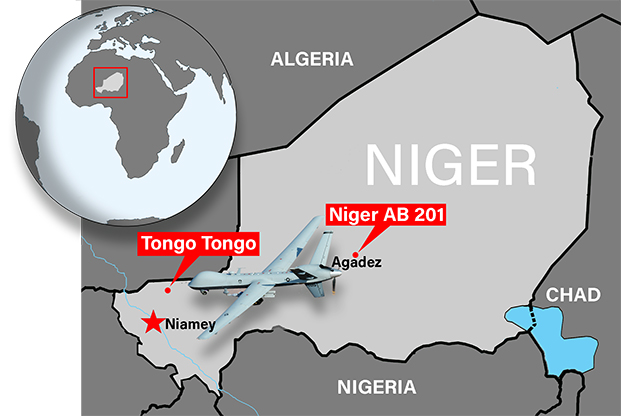
Staff illustration: Mike Tsukamoto
AFRICOM TO INCREASE ISR SUPPORT AND LIMIT MISSIONS IN WAKE OF 2017 AMBUSH. REAPERS ARE THERE TO HELP.
US special operations forces in Africa are paring down their operations and will be supported by an increase in Air Force-provided surveillance from a large USAF operating location in Niger, following the Oct. 4, 2017, ambush in that country that killed four US Army Green Berets.
The Pentagon in May unveiled its long-anticipated investigation into the ambush. At the time, an under-protected group of soldiers was surrounded and outgunned by more than 100 enemy fighters in a mission that was not accurately described to higher US Africa Command officials by lower-level commanders.
The ambush killed four soldiers: SSgt. Bryan Black, SSgt. Jeremiah Johnson, SSgt. Dustin Wright, and Sgt. La David Johnson.
The USAFRICOM investigation into the incident found that several failures in training, command oversight, and a lack of understanding of the special operations mission in the region resulted in the fatal attack. The investigation focused on interviews with more than 140 personnel, visits to the location of the incident, and review of video provided by ISR and French attack jets.
“With the conclusion of the investigation, it is my duty and obligation to make required changes and adjustments to how US military forces conduct daily operations on the African continent,” AFRICOM Commander USMC Gen. Thomas D. Waldhauser said in a May Pentagon briefing. “Consequently, I will ensure the lessons learned are communicated to all levels within AFRICOM, as well as within the component commands and integrate these changes into our daily operational activities.”
The investigation did not highlight a single major point of failure, and did not specifically recommend any punishment for personnel involved. There will eventually be valor awards presented, which were earned by the four fallen soldiers who continued to fight in their final minutes, Waldhauser said.
The team of Green Berets was accompanying Nigerien forces on what was originally portrayed in a concept of operations to be a routine counterterrorism reconnaissance mission to a village near Niamey. Instead, the mission was a kill-or-capture mission focused on a local ISIS leader.
The investigation states that two Army captains did not accurately portray the mission and AFRICOM officials were unaware of the actual focus. Had they been, the mission would have required higher-level approval and likely more resources, including air support and armored vehicles.
The patrol began Oct. 3, 2017,with a US remotely piloted aircraft accompanying the team from Niamey. The RPA watched the nearby village for several hours, but the soldiers determined it was “cold” and ordered the aircraft to fly further north to watch border crossing locations. The ambush began at about 11:40 a.m. the next day, after the teams stopped in the village of Tongo Tongo for water. At first the group believed the attacking enemy force was small and could be handled, so they did not initially call for support. More ISIS fighters emerged from vehicles and began to surround the forces. The soldiers and Nigeriens were ordered to withdraw.
Unfortunately, a truck containing three of the US soldiers, one US soldier on foot, and two Nigerien vehicles did not withdraw from the ambush site and were separated from the larger group.
Waldhauser said that up until this point, US troops had “never seen anything in this magnitude” from ISIS in Africa, noting the ISIS fighters had tactical surprise. The rest of the US and Nigerien forces relocated about 700 meters away. Their commander had ordered them to flee not knowing what happened to the four remaining US soldiers.
It took an hour and 45 minutes for the first ISR aircraft to arrive on scene, said Army Maj. Gen. Roger L. Cloutier Jr., AFRICOM’s chief of staff, who oversaw the investigation. Two French Mirage fighters arrived shortly after they were notified, and flew four show-of-force low passes at about treetop level to disperse the fighters. However, the French jets were unable to identify targets as friend or foe without direct radio contact and did not engage.
A Nigerien quick-reaction force arrived four hours and 25 minutes after initial contact, and a medical evacuation team withdrew the fallen about five hours and 43 minutes after initial contact.
ISIS fighters had removed all useable equipment from the US and Nigerien forces, and three bodies of US soldiers were found in ISIS trucks, indicating they had tried to take them from the scene, Cloutier said. Since the incident, the Pentagon and AFRICOM leadership have ordered US special operations forces to find ways to further mitigate risk, including limiting the missions that could include contact with enemy fighters. Those missions need a “strategic value” and must include target groups that pose a “strategic threat” to the US. There is a renewed emphasis on the “by, with, and through” focus of special operations, meaning that local forces need to be in the front and deal with potential fighting, Waldhauser said.
There will be a larger focus by AFRICOM, US Special Operations Command, and the US Army on pre-deployment and in-theater training, as well as the rehearsal of missions, to try to mitigate risk. AFRICOM has provided access to more armored vehicles, “increased firepower,” and more capacity to limit response times.
A major focus is on intelligence, surveillance, and reconnaissance capacity. USAF has an MQ-9 Reaper presence deployed to Nigerien Air Base 201 near Agadez with the 323rd Expeditionary Reconnaissance Squadron. Airmen from the 724th Expeditionary Air Base Squadron and 31st Expeditionary RED HORSE Squadron, along with Army military police and the Navy Seabees are working to improve the base.
“Our host nation was kind enough to let us set up a temporary base next to their local military basic training site while we established our base, eventually building up a flight line for air operations,” said First Lt. Danielle Tabb, Civil Engineer Flight commander and base civil engineer, in an AFRICOM release just days before the deadly ambush.
“We’re in the very early stages right now of establishing a presence in the area, but one day this once empty desert will be a fully functioning flight line,” Tabb added.
Since then, the US has “beefed up a lot of things posture-wise with regards to these forces,” Waldhauser said in May.
—BRIAN W. EVERSTINE
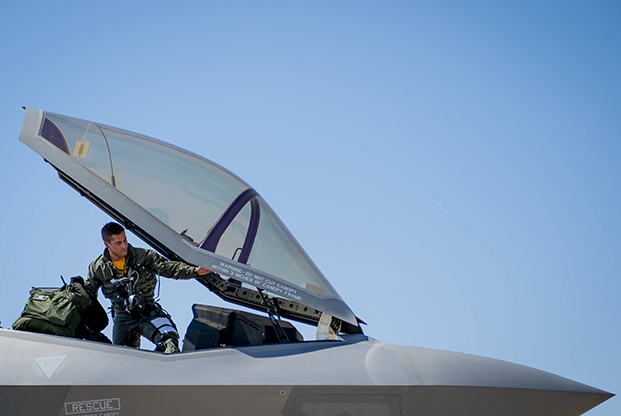
Capt. Michael Slotten climbs into an F-35 at Luke AFB, Ariz., in July, for training at the Barry M. Goldwater Range. Photo: SSgt. Jensen Stidham
THERE’S ROOM TO IMPROVE THE F-22, F-35 TRAINERS
The Air Force’s training chief wants F-22 and F-35 basic instruction aircraft modified to full-combat capability, but he is also exploring ways to provide all-up training if that proves unaffordable.
Lt. Gen. Steven L. Kwast, head of Air Education and Training Command, said teaching flying with out-of-date jets poses a danger of “negative learning” or the need for expensive further training when junior F-22 and F-35 pilots reach frontline units. But he recognizes, “it all comes down to money,” as to whether USAF can afford the modifications.
“What I want is, I want my cake and [to] eat it, too. I’d like all our aircraft concurrent,” so that when there’s a software update to the F-35 and F-22 fleets, even the training aircraft get it so “we have congruency” among the platforms. “I don’t want to live with … an architecture where the fighter has a different [software] load than the trainer. That’s unacceptable to me. So I do not want to take pressure off that,” he said.
However, “in the short run,” given the demands to fix readiness issues and aircraft age across the force, as well as “the hole we’re in with sequestration,” Kwast said, “we can’t do everything.” As a stopgap, he said USAF is looking into virtual technologies that can teach stealth pilots the capabilities in the latest versions of their jets while they get the necessary “visceral” experience—the environment around the jet, the cockpit, takeoffs, and landings, etc.—in the real thing.
An Air Force lab in Austin, Texas, is finding out that the brain is “phenomenal at ‘blending’” the visceral experiences with the more “cognitive” aspects of employing the aircraft, Kwast said. The visceral tasks can be learned easily and quickly, but the cognitive elements take “a lot of repetitions,” and a virtual reality approach will help drive down costs of teaching them, he explained.
VR approaches can also offer a training space where pilots “can properly train the habits of mind of the frontline aircraft where there are no limits to range space, … weather, … adversaries, … or threat emitters that may or may not be accurate waveforms.” They can “practice the habits of decision-making.”
These applications should be available soon, Kwast said, but he’s not giving up on getting the training jets compatible with frontline aircraft.
“We’re building this model so you have the speed and agility … to have access to this training on-command, on-demand, on any device, anywhere in the world,” Kwast added. “Now, there are security issues, but those security issues are relatively easy to solve.” He plans on “flooding the market” with such devices so pilots of any jet can reap the same benefits, such as being able to train when the weather doesn’t cooperate.
“We are … already migrating” the VR technology “to some pilot training bases as a testbed,” Kwast noted. He’s hoping the technology will “spread like wildfire.”
—JOHN A. TIRPAK
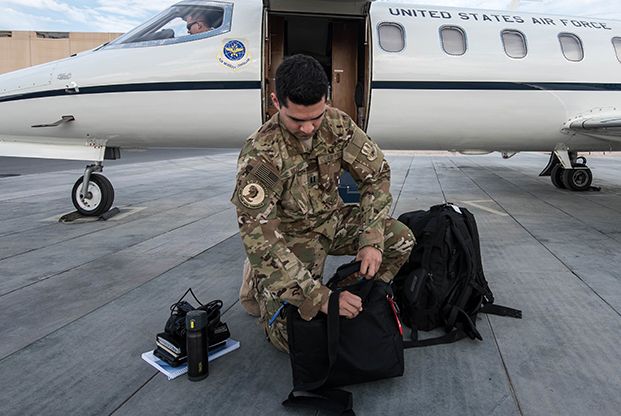
Capt. Ramiro Rios, a C-21 pilot, sports the Operational Camouflage Pattern uniform, which has until now been worn only by the US Army. Photo: MSgt. Phil Speck
USAF WILL USE ARMY CAMO PATTERN
The Air Force is officially making another uniform change, transitioning to the US Army’s Operational Camouflage Pattern (OCP) in a phased approach with the goal to fully transition by April 1, 2021.
Beginning Oct. 1, airmen who own serviceable OCP-patterned uniforms can wear them. Distribution is limited at first to allow manufacturers to produce enough stock.
Enlisted airmen will see an increase to their clothing allowances on Oct. 1. Beginning April 1, 2019, airmen can purchase the uniform at any AAFES store that carries them. AAFES will sell them online around October 2019, according to the release. Those in Basic Military Training, Reserve Officer Training Corps, and Officer Training School will receive the uniforms beginning Oct. 1, 2019.
The decision to transition to the Army uniform came after feedback from airmen that it is the “best, battle-tested utility uniform available,” according to the release.
“We looked at all utility uniforms currently in our inventory to find the best-of-breed,” USAF Chief of Staff Gen. David Goldfein L. said in the release. “We spoke to and listened to airmen on this, and the OCP was the clear choice.” The uniform can work in all climates—”from Minot to Manbij [Syria],” he said. More than 100,000 airmen already have OCPs, including those deployed to US Central Command, in special operations, mobility crews, and security forces in Global Strike Command. The transition means these airmen will only need one uniform, instead of separate uniforms to be worn while deployed or at home station.
The Air Force’s take on the OCP will include the wearing of squadron patches, spice-brown lettering on the name tape and Air Force lettering, along with tan T-shirts and belts. Special functional identifiers—security forces, combat controller, etc.—and unit patches will be worn on the left sleeves, with the US flag and headquarters patches on the right sleeves.
—BRIAN W. EVERSTINE
CERTIFYING THE NUCLEAR FLEET IN A CYBER WORLD
The Air Force is already thinking about how it will certify its nuclear systems in a cyber environment. That’s a significant challenge considering the last time it certified such a system—the B-2 in the early 1990s—the internet didn’t exist, at least not as it does today.
“We built a plan on how to execute that because the time to worry about nuclear certification of our systems is not 2020, it’s 2018. You plan for it now,” said Lt. Gen. Jack Weinstein, deputy chief of staff for strategic deterrence and nuclear integration, during a May AFA-Mitchell Institute event on Capitol Hill.
Nuclear certification is the final step before a nuclear weapon system can reach initial operational capability. In 2017, the Air Force Scientific Advisory Board (SAB) conducted a study on “Nuclear Surety and Certification for Emerging Systems,” in which the board offered several recommendations, including ensuring the Nuclear Weapons Center, Safety Center, and the NWS Program Offices were properly resourced “to support modernization.”
Weinstein said once briefed, Air Force Secretary Heather Wilson gave him 30 days to complete a plan to implement those recommendations, which he did. Now the service is working to ensure it hires “the right people” in those locations, so they can start thinking about the issue sooner rather than later.
The SAB also recommended USAF place more emphasis “on the reliability element of surety” in order to “address the evolving threat to [the] USAF nuclear mission;” develop policies and procedures aimed at addressing cybersecurity in nuclear systems; and work with the National Security Agency to “develop a calculus for cyber resiliency” that includes a quantitative analysis of mission impact, among other suggestions.
Weinstein said his staff is in the process of completing the congressionally mandated Nuclear Mission Assessment, which takes a broad look at USAF’s nuclear enterprise, including how the nuclear force is trained, the proper size of the force, whether there is enough money to support the force and the ongoing modernization efforts, and what is the warfighting capability. That assessment, he said, will be presented to Wilson and Chief of Staff Gen. David Goldfein by the end of the year.
“I think it’s really healthy to take all of those items and put it together. We were already looking at them, now they are being looked at holistically,” said Weinstein.
—AMY MCCULLOUGH
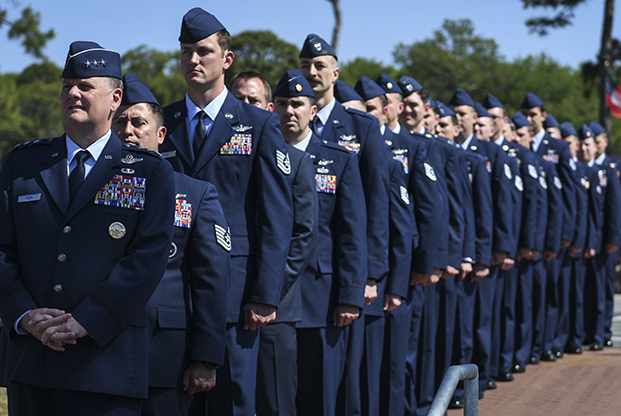
Lt. Gen. Brad Webb, AFSOC commander, leads air commandos with the 4th SOS about to receive the DFC medal into a ceremony at Hurlburt Field, Fla. Photo: A1C Rachel Yates
TWENTY-FOUR AIRMEN EARN DFCs FOR AC-130 MISSIONS
Twenty-four airmen from the 4th Special Operations Squadron at Hurlburt Field, Fla., were awarded Distinguished Flying Crosses for four separate engagements, all of which included an AC-130 protecting friendly forces. “All of the DFCs presented today were earned in the dangerous skies of Afghanistan,” Air Force Special Operations Command boss Lt. Gen. Brad Webb said in a release. “Although dates and objectives differ, the general mission remained the same, … defend Americans and their partner forces, and decimate the enemy.”
Twenty-one airmen received the awards during the Hurlburt ceremony, and three were unable to attend.
The first of the engagements took place on July 25, 2016, when an AC-130U was providing high-risk daylight protection for 114 US and Afghan special operations forces in the Nangarhar Province. After more than 50 insurgents ambushed the team, the gunship used danger-close 105 mm howitzer rounds within 120 meters of friendly forces. The AC-130U ran low of fuel, so the crew coordinated another gunship to arrive. The enemy’s attack intensified as the second AC-130 arrived on station, so the two worked in tandem and began engaging with a total of four guns at the same time. The attack continued, and a third AC-130 launched. Thirty-one enemy were killed, 28 structures were destroyed, and no friendly forces were killed.
On March 29, 2017, another aircrew was flying support for 35 US and Afghan special operations forces when they came under attack in the Kot Valley of Nangarhar Province. Sixty-five insurgents attacked with “overwhelming hostile fire.” The AC-130 dropped to a lower altitude and fired for about 90 minutes. Twenty-one of the 25 attacks were danger-close, and the AC-130 pilots received MANPADS (man-portable air defense systems) launch indications during the fight, according to the release. The airpower helped repel the ambush with no friendly casualties.
On April 8, 2017, another crew was flying support for 281 US and Afghan special operations forces again near Nangarhar. When the AC-130 arrived on scene, coalition forces were already taking fire. The aircrew needed to provide continuous fire while being judicious about ammunition usage. As the fight continued, the aircraft commander called for another AC-130 with a bigger armament load and more fuel. The crew returned to base, immediately transferred to the other AC-130, and returned to the fight. The crew ultimately emptied two AC-130s, killing 32 enemies and destroying a weapons cache.
On May 24, 2017, the last crew was flying support for 378 US and Afghan special operations forces in Nangarhar when they were attacked. The crew accurately fired on the enemy forces “within seconds” of verifying positions, despite dealing with electrical issues and gun malfunctions, eliminating the threats.
—BRIAN W. EVERSTINE
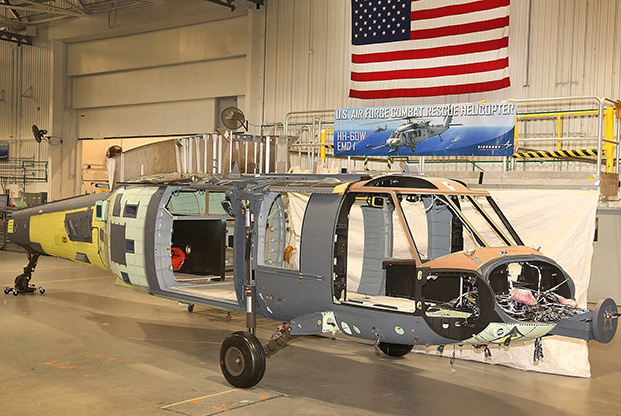
The first Sikorsky HH-60W Combat Rescue Helicopter as it enters final assembly at Stratford, Conn., in February. Photo: Sikorsky
SIKORSKY PUSHING FOR EARLY COMBAT RESCUE HELICOPTER PRODUCTION DECISION, DELIVERIES
STRATFORD, Conn. — The next generation of Air Force combat rescue is taking shape on a new Connecticut production line, where two development models of the HH-60W helicopter are undergoing final assembly ahead of flight testing late this year.
Sikorsky officials are confident in the progress on the helicopter, known in the factory as “Whiskey,” heartened by the Air Force’s budget request of $1.14 billion in Fiscal 2019. The funds will help accelerate development and shrink the deployment schedule. When the original $1.28 billion contract for engineering, manufacturing, and development (EMD) for the helicopter was awarded in June 2014, it launched a 75-month program aimed at delivery on Sept. 26, 2020. Sikorsky is now executing a schedule envisioning a Milestone C production decision in the third quarter of 2019, and delivery in March 2020, nearly six months ahead of the original schedule.
“We’re gonna be in there,” Tim Healy, Sikorsky’s head of Air Force programs, said at the production facility on May 23. “We’re gonna be close.” Healy explained Milestone C is the most important because “it gets capability to the warfighter.”
Air Force Magazine was the first media organization to visit the combat rescue production line, where the two EMD models move along a reconfigured line next to where Sikorsky is building new MH-60R Seahawk helicopters for the Navy. One Whiskey model is stuffed with thousands of feet of orange cables and hundreds of small sensors for collecting flight test data.
The Air Force plans to purchase 112 of the aircraft. The Whiskey model is a heavily modified version of the Army’s latest iteration of the UH-60 Black Hawk, the UH-60M. The modernized cockpit has four large displays fed by two advanced mission computers. The data presented include information from the helicopter’s five radios, radar, infrared cameras, radar warning system, laser warning system, missile warning system, and multiple data links. They include Link 16, Situational Awareness Data Link, and Common Integrated Broadcast.
The advanced avionics include new capabilities, such as a touch-of-a-button program to choose a hovering location. A pilot flying over water for a rescue will be able to press a button when the HH-60W flies over the site, and onboard computers would calculate environmental and wind conditions, then automatically circle the aircraft back to hover over that spot without further inputs. Pararescuemen could then deploy.
Mission avionics reside in the nose of the helicopter. While Sikorsky admits the new fairings on the nose will make it difficult for USAF rescue crews to paint the trademark “Pedro” mustache on the aircraft—as they do with today’s Pave Hawk fleet—the heavier weight on the front provided a bonus. It changed the center of gravity on the helicopter, letting designers strengthen the frame and place a larger fuel tank behind the cabin to balance things out.
The generic Black Hawk, upon which the HH-60G is based, uses a 360-gallon fuel tank. Air Force crews need more fuel for longer flights, so the Pave Hawk is usually fitted with large auxiliary tanks. The Whiskey’s internal fuel tank, though, is 660 gallons, which means auxiliary tanks aren’t needed to meet the required mission profile: 195 nautical miles range, a 10-minute hover, and then another 195 miles.
The pilots enjoy increased ballistic protection by way of thicker armor. The armor plating in the Pave Hawk only protects from standard 7.62 mm ball ammunition but the W model will add protection from 7.62 mm armor-piercing rounds.
Versus the Pave Hawk, the W model has a “more elegant” side-gun mounting design, Healy said. They won’t stick out as far from the aircraft and will be able to universally accept GAU-2, GAU-18, and GAU-21 guns.
Special mission aviators and pararescuemen will be able to see mission data in the back of the aircraft, where three full-color displays are mounted. For the first time, pararescuemen will have crash-worthy seats, which can be folded up to the ceiling of the cabin. In the Pave Hawk, PJs sit on the cabin floor and take their chances.
First flight is expected late in the fourth quarter of this year at Sikorsky’s facility in West Palm Beach, Fla. After first flight, the sensor-laden aircraft will go to the Air Force in the second quarter of 2019, in preparation for the big full-production decision the following quarter, Healy said. The current schedule would get the CRH to “the men and women who need the platform … one fiscal year earlier,” Healy said.
The Air Force’s budget request, which is the first installment on a $5.1 billion, five-year production effort, is meant to “incentivize” Sikorsky/Lockheed Martin to move quickly.
If the contractors reach the milestone early, “we immediately go into production and buy aircraft at a certain rate,” the Air Force’s top uniformed acquisition officer, Lt. Gen. Arnold Bunch, said in October 2017.
Sikorsky is under contract for 39 training “devices,” which will include full-motion simulators for the pilots and special mission aviators. Additionally, there are operational flight trainers and part-task trainers focused on systems such as landing gear and hoists. Sikorsky is also developing maintenance system trainers for crew chiefs to work on at the JB Langley- Eustis, Va., schoolhouse.
—BRIAN W. EVERSTINE